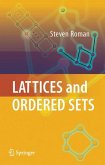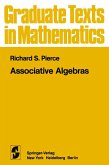From the reviews:
"Lattice-ordered rings and modules are of interest both to algebraists and to functional analysts. Previous authors have presented only those results that are needed for the applications that they have in mind. Having a book like this one would be a great boon. Both the algebraists and the analysts would benefit from having the fundamental results all gathered together in one book. This book would fill in the gap admirably.
Any algebraist or functional analyst whose work involves ordered structures would be interested in this book. That includes mathematicians who study: lattices, ordered semigroups, ordered groups, ordered rings, ordered fields, Riesz spaces, vector lattices, or Banach lattices. It would also be useful for mathematicians who are interested in general ring theory, general group theory, matrix algebras, or function algebras (especially Banach algebras). In short, there is a wide audience who would find the tools that this book provides very useful."
"Lattice-ordered rings and modules are of interest both to algebraists and to functional analysts. Previous authors have presented only those results that are needed for the applications that they have in mind. Having a book like this one would be a great boon. Both the algebraists and the analysts would benefit from having the fundamental results all gathered together in one book. This book would fill in the gap admirably.
Any algebraist or functional analyst whose work involves ordered structures would be interested in this book. That includes mathematicians who study: lattices, ordered semigroups, ordered groups, ordered rings, ordered fields, Riesz spaces, vector lattices, or Banach lattices. It would also be useful for mathematicians who are interested in general ring theory, general group theory, matrix algebras, or function algebras (especially Banach algebras). In short, there is a wide audience who would find the tools that this book provides very useful."
From the reviews:
"Lattice-ordered rings and modules are of interest both to algebraists and to functional analysts. Previous authors have presented only those results that are needed for the applications that they have in mind. Having a book like this one would be a great boon. Both the algebraists and the analysts would benefit from having the fundamental results all gathered together in one book. This book would fill in the gap admirably.
Any algebraist or functional analyst whose work involves ordered structures would be interested in this book. That includes mathematicians who study: lattices, ordered semigroups, ordered groups, ordered rings, ordered fields, Riesz spaces, vector lattices, or Banach lattices. It would also be useful for mathematicians who are interested in general ring theory, general group theory, matrix algebras, or function algebras (especially Banach algebras). In short, there is a wide audience who would find the tools that this book provides very useful."
"Lattice-ordered rings and modules is the latest in a line of books aimed at simultaneously detailing the history while up-dating the canon of the theory of lattice-ordered groups and rings. ... The author has been able to create a book that is both accessible to graduate students and useful to researchers. ... the material is presented in a clear and well-written manner ... every researcher in the areas of lattice-ordered groups and rings will come to possess a copy of Lattice-ordered rings and modules." (Warren Wm. McGovern, Mathematical Reviews, Issue 2011 b)
"This book gives a comprehensive account of the algebraic aspects of the theories of lattice-ordered rings and those lattice-ordered modules which can be embedded in a product of totally ordered modules, the f-modules. It is written at a level suitable for gifted second-year graduate students in mathematics and ... serve as a monograph for researchers in these fields. ... A list of 27 openproblems concludes the book, which will be the text of reference to lattice-ordered rings and modules for many years to come." (H. Mitsch, Monatshefte für Mathematik, Vol. 162 (3), March, 2011)
"This is an excellent book on lattice-ordered groups, rings and, especially, modules. ... there are more than 800 extensive exercises in the book. Another advantage of the book is that at the end of every chapter there is a useful Note which provides the references used in the chapter. Finally, the book ends with 27 interesting open problems." (Yichuan Yang, Zentralblatt MATH, Vol. 1205, 2011)
"Lattice-ordered rings and modules are of interest both to algebraists and to functional analysts. Previous authors have presented only those results that are needed for the applications that they have in mind. Having a book like this one would be a great boon. Both the algebraists and the analysts would benefit from having the fundamental results all gathered together in one book. This book would fill in the gap admirably.
Any algebraist or functional analyst whose work involves ordered structures would be interested in this book. That includes mathematicians who study: lattices, ordered semigroups, ordered groups, ordered rings, ordered fields, Riesz spaces, vector lattices, or Banach lattices. It would also be useful for mathematicians who are interested in general ring theory, general group theory, matrix algebras, or function algebras (especially Banach algebras). In short, there is a wide audience who would find the tools that this book provides very useful."
"Lattice-ordered rings and modules is the latest in a line of books aimed at simultaneously detailing the history while up-dating the canon of the theory of lattice-ordered groups and rings. ... The author has been able to create a book that is both accessible to graduate students and useful to researchers. ... the material is presented in a clear and well-written manner ... every researcher in the areas of lattice-ordered groups and rings will come to possess a copy of Lattice-ordered rings and modules." (Warren Wm. McGovern, Mathematical Reviews, Issue 2011 b)
"This book gives a comprehensive account of the algebraic aspects of the theories of lattice-ordered rings and those lattice-ordered modules which can be embedded in a product of totally ordered modules, the f-modules. It is written at a level suitable for gifted second-year graduate students in mathematics and ... serve as a monograph for researchers in these fields. ... A list of 27 openproblems concludes the book, which will be the text of reference to lattice-ordered rings and modules for many years to come." (H. Mitsch, Monatshefte für Mathematik, Vol. 162 (3), March, 2011)
"This is an excellent book on lattice-ordered groups, rings and, especially, modules. ... there are more than 800 extensive exercises in the book. Another advantage of the book is that at the end of every chapter there is a useful Note which provides the references used in the chapter. Finally, the book ends with 27 interesting open problems." (Yichuan Yang, Zentralblatt MATH, Vol. 1205, 2011)








